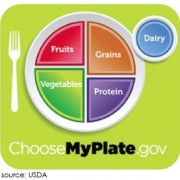Classic food pyramid receives a makeover
Lucia Sandberg
Page Editor
 This June, the classic food pyramid, displayed in cafeterias and on cereal boxes alike, received a makeover administered by the United States Department of Agriculture (USDA).
This June, the classic food pyramid, displayed in cafeterias and on cereal boxes alike, received a makeover administered by the United States Department of Agriculture (USDA).
The new “pyramid” is actually modeled after a plate and has been divided into sections to represent what portion of each meal should be made up of the different food groups (i.e., protein, fruits, grains, vegetables, and dairy). The old shape of the pyramid was difficult for many to understand. It wasn’t visually clear how food groups should be portioned for each meal.
The USDA encourages smaller portions in general and recommends balancing calories by “enjoy[ing] your food, but eat[ing] less.” The USDA also urges Americans to forego a sugary, carbonated drink and opt for water instead. Grains should be whole grains, and milk should be fatfree or low-fat.
The goal of the new food plate (pictured to the left) is to encourage Americans to eat much healthier, smaller portions by providing a clearer visual model. With obesity rates in the United States skyrocketing, (over 1/3 of Americans are overweight) the new plate is certainly a worthwhile effort.
Original Article:



